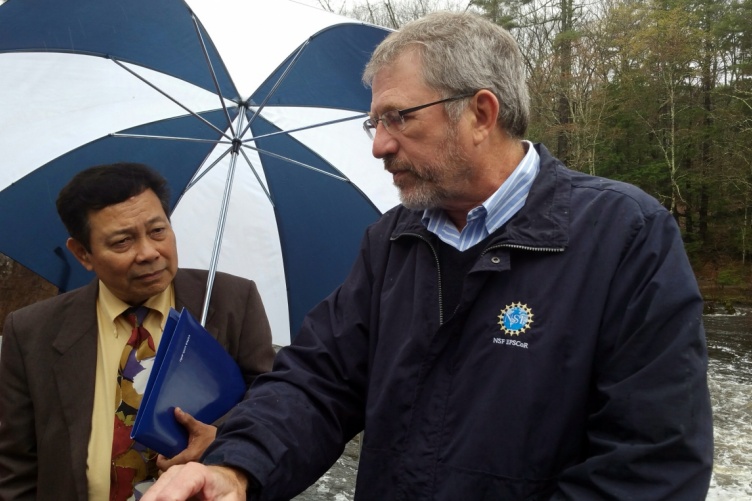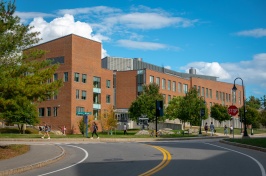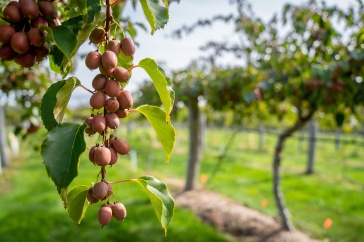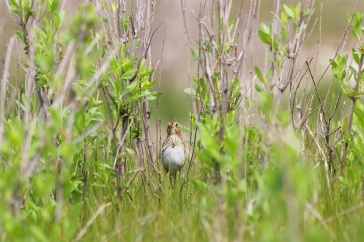
Dr. Catalino Blanche (left) learns about Dr. William McDowell's experiment station-funded research at the Wiswall Dam.
The NH Agricultural Experiment Station at the University of New Hampshire recently welcomed Dr. Catalino Blanche, national program leader in the Division of Environmental Systems with the U.S. Department of Agriculture. Blanche provides national leadership for forestry and research programs related to the production, protection, and utilization of forest resources, including for the McIntire-Stennis Cooperative Forestry Program.
During his day-long visit Wednesday, April 26, 2017, Blanche met with Dr. Jon Wraith, dean of the UNH College of Life Sciences and Agriculture and director of the NH Agricultural Experiment Station, Dr. Anita Klein, faculty fellow for the experiment station, and numerous faculty who conduct forestry and ecological research funded by McIntire-Stennis Cooperative Forestry Program. He also learned about the experiment station’s extensive history of conducting forestry and ecological research funded by McIntire-Stennis.
“The McIntire-Stennis Cooperative Forestry Program funds important experiment station research that directly supports the state’s $2.4 billion forest products-based economy. For more than 50 years, our researchers have studied the economically important eastern white pine, developed high-tech forest inventorying systems, helped improve the management of forest resources, assessed the forestry economy and markets, and researched emerging issues related to ecosystem services such as climate variability and nitrogen deposition,” Wraith said. “It was a pleasure to share this history with Dr. Blanche.”
“University of the White Pine”
The University of New Hampshire is known as the “University of the White Pine” within the New England forestry community. The eastern white pine has been the backbone of the New Hampshire timber industry for centuries and remains today as one of the state’s most economically important and valuable tree species.
Experiment station researchers have conducted extensive research on this important timber resource for decades and are considered the go-to experts on topics such as white pine growth and yield, management, disease, response to fertilizers, and competition with non-native invasive species. Early research evaluated white pine yields and the species’ response to fertilizers. They also developed computer programs simulating the growth of white pine and investigated the impacts of thinning and prescribed fire on the growth of pine stands. More recently, scientists have been investigating how to control non-native invasive species such as glossy buckthorn, which outcompete eastern white pine seedlings.
High-Tech Forest Inventorying

The university acquired its first computer in 1962, and soon thereafter, experiment station scientists began using linear programming to analyze forest management. While that marked the beginning of the experiment station’s efforts to use the latest computer-based technologies available to develop sophisticated forest inventorying systems, station scientists had been using low-level aerial photography since the 1940s. In recent decades, scientists also have employed remote sensing, GIS, Landsat 5 TM imagery, and spatial data analysis to assist foresters and landowners in accurately assessing forest inventories. Recently, researchers have been using laser imaging – aerial and terrestrial LiDAR – and drones to map forests and improve forest management.
Forest Resource Management
Managing forest resources has been a key research area for experiment station scientists. Researchers have investigated the impact of diseases such as powdery mildew, sooty mold, and fireblight on shade trees. Researchers also are investigating the use of the Smokey Winged Beetle Bandit to help monitor the emerald ash borer, a beetle that has been spreading across the United States killing ash trees for more than two decades. Recently researchers identified and described five new truffle species, including two that have been found only in New Hampshire. Although these “deer truffles” are not considered the prized gourmet edibles, they are a key food source for animals and play an important role in the mycorrhizal networks that enable trees to take up nutrients from the soil. Finally, experiment station scientists have been assessing land use change, including its environmental impacts, and town forest resources since the 1940s.
Forestry Economy and Markets
The forestry economy and the markets it creates are central to New Hampshire’s economy. Experiment station researchers have investigated numerous aspects of the forestry economy, including markets for timber, fuel wood, wood shavings as animal bedding, Christmas trees, and the economic value of outdoor recreational opportunities.
Ecosystem Services

Research on ecosystem services continues to be a growing area of inquiry for experiment station scientists, especially issues related to climate variability and nitrogen deposition. For example, researchers recently assessed how different tree species fared during the 2016 New England drought. This is part of a broader effort that is investigating the impacts of climate change and altered rainfall patterns on forest health, productivity, and hydrology. Experiment station scientists also are conducting increasing research on the environmental issues facing the state’s forested watersheds. In particular, scientists have conducted numerous studies on changes in nitrogen levels in streams and rivers and their potential links to atmospheric deposition, fertilizer use, septic systems, and animal agriculture. Researchers also are using bats to sample forest insect populations as an early detection system for future insect pest invasions. Finally, researchers are investigating the genetic diversity of bobcats and the impact of urbanization and habitat fragmentation on the population. These data will be useful to forest landowners and managers making management decisions regarding forest land protection efforts to increase connectivity among bobcat populations.
This material is based upon work supported by the NH Agricultural Experiment Station, through joint funding of the National Institute of Food and Agriculture, U.S. Department of Agriculture, and the state of New Hampshire.
Founded in 1887, the NH Agricultural Experiment Station at the UNH College of Life Sciences and Agriculture is UNH’s original research center and an elemental component of New Hampshire's land-grant university heritage and mission. We steward federal and state funding, including support from the USDA National Institute of Food and Agriculture, to provide unbiased and objective research concerning diverse aspects of sustainable agriculture and foods, aquaculture, forest management, and related wildlife, natural resources and rural community topics. We maintain the Woodman and Kingman agronomy and horticultural research farms, the Macfarlane Research Greenhouses, the Fairchild Dairy Teaching and Research Center, and the Organic Dairy Research Farm. Additional properties also provide forage, forests and woodlands in direct support to research, teaching, and outreach.
-
Written By:
Lori Tyler Gula, PhD | NH Agricultural Experiment Station | lori.gula@unh.edu | 603-862-1452


















































